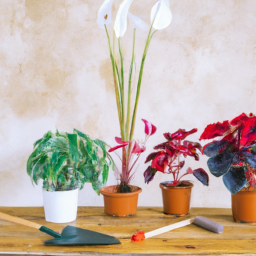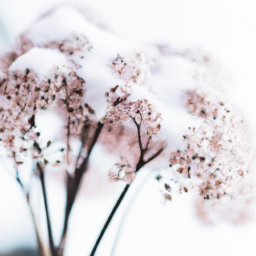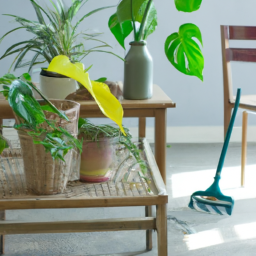
Hey there plant lovers! Are you tired of seeing your beloved indoor plants struggle and wilt during certain times of the year? Well, fret no more! In this blog post, we will be diving into the topic of indoor plant care by season, providing you with valuable tips and tricks to ensure your plants thrive all year round. Whether you’re a seasoned plant parent or just starting out, these tips for every time of year will help you keep your indoor plants happy and healthy. So, let’s get started and give your green friends the love and attention they deserve!
Indoor Plant Care by Season: Tips for Every Time of Year
1. Spring Indoor Plant Care: Essential Tips for the Growing Season
Spring is a wonderful time for indoor plants as they come out of their winter dormancy and start to thrive again. As an indoor plant enthusiast, it’s important to provide the necessary care and attention to ensure your plants have a successful growing season. In this guide, we will explore essential tips for spring indoor plant care to help you keep your plants healthy and vibrant.
Understanding Spring Growth
During spring, indoor plants experience a surge in growth. They require more water, sunlight, and nutrients to support this rapid growth. It’s crucial to observe your plants closely and make adjustments to their care routine accordingly.
1. Watering: As the temperature rises, your plants will need more water. Check the moisture level of the soil regularly and water thoroughly when the top inch of soil feels dry to the touch. Be careful not to overwater, as this can lead to root rot. Ensure proper drainage by using pots with drainage holes.
2. Sunlight: Spring brings longer days and increased sunlight. Place your plants near windows with bright, indirect light. Rotate them every few days to ensure even growth and prevent leaning towards the light source. If your plants show signs of sunburn, move them to a slightly shadier spot.
3. Fertilizing: Spring is the perfect time to start fertilizing your indoor plants. Choose a balanced, water-soluble fertilizer and apply it according to the package instructions. Fertilize every two to four weeks to provide the necessary nutrients for healthy growth.
Dealing with Pests and Diseases
Spring also brings an increase in pests and diseases. It’s important to be vigilant and take preventive measures to protect your indoor plants.
1. Pest Control: Inspect your plants regularly for signs of pests such as aphids, spider mites, and mealybugs. If you spot any, isolate the affected plant and treat it with an appropriate insecticide or insecticidal soap. Avoid using harsh chemicals that can harm your plants.
2. Disease Prevention: Proper air circulation is essential to prevent fungal diseases. Avoid overcrowding your plants and ensure good airflow around them. Remove any dead or yellowing leaves promptly to prevent the spread of diseases.
3. Cleaning: Spring is a great time to give your plants a thorough cleaning. Dust can accumulate on their leaves, hindering photosynthesis. Gently wipe the leaves with a damp cloth or use a soft brush to remove dust and keep them healthy.
Preparing for Summer
As spring transitions into summer, it’s important to prepare your indoor plants for the changing conditions.
1. Repotting: Spring is an ideal time to repot your plants if they have outgrown their current containers. Choose a slightly larger pot with good drainage and fresh potting soil. Repotting will provide your plants with the necessary space and nutrients to thrive during the upcoming summer months.
2. Pruning: Prune your plants in spring to remove any dead or leggy growth. This will encourage bushier and healthier growth during summer. Use clean and sharp pruning shears to avoid damaging the plants.
3. Outdoor Time: Consider taking your indoor plants outside during mild spring days. This will expose them to natural sunlight and fresh air, promoting stronger growth. However, be cautious of sudden temperature drops or extreme weather conditions that can harm your plants.
In conclusion, spring is an exciting time for indoor plant care. By following these essential tips, you can ensure your plants have a successful growing season and thrive throughout the year. Remember to observe your plants closely, adjust their care routine accordingly, and protect them from pests and diseases. With proper care, your indoor plants will bring beauty and joy to your home.
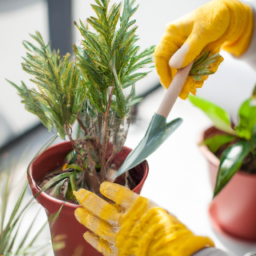
Summer Indoor Plant Care: Keeping Your Plants Hydrated and Thriving
Summer is a challenging time for indoor plants as the intense heat and increased humidity can affect their growth and overall health. However, with proper care and attention, you can ensure that your indoor plants stay hydrated and thrive throughout the summer months. In this guide, we will provide you with essential tips and techniques to keep your indoor plants happy and healthy during the summer season.
1. Watering your indoor plants during summer
Watering is crucial during the summer months as plants tend to lose more moisture due to increased evaporation. However, it is important to strike a balance and not overwater your plants. Here are some tips to help you water your indoor plants effectively:
a) Observe your plants: Each plant has different water requirements. Monitor the soil moisture level and observe your plants for any signs of dehydration or overhydration. Adjust your watering schedule accordingly.
b) Water deeply: When you water your plants, make sure to water deeply until the water drains out from the bottom of the pot. This ensures that the roots receive sufficient moisture.
c) Use the right watering technique: Avoid watering the leaves directly as it can lead to fungal diseases. Instead, water the soil around the plant base. You can use a watering can or a drip irrigation system for better control.
d) Consider the humidity: Summer often brings high humidity levels. If the humidity is already high, you may need to reduce the frequency of watering to prevent root rot and other fungal issues.
2. Provide adequate light and shade
During summer, the intensity of sunlight increases, which can be both beneficial and harmful to indoor plants. Here’s how you can ensure your plants receive adequate light without getting scorched:
a) Find the right spot: Identify the ideal location for each plant based on its light requirements. Some plants may prefer bright, indirect light, while others may thrive in partial shade. Place them accordingly.
b) Rotate your plants: If your plants are getting direct sunlight, consider rotating them every few days to ensure even growth and prevent sunburn on specific sides.
c) Use sheer curtains or blinds: If your plants are receiving intense sunlight, you can use sheer curtains or blinds to filter the light and provide some shade. This will protect your plants from burning.
3. Maintain proper ventilation and airflow
Good air circulation is essential for the overall health of your indoor plants, especially during the hot summer months. Here are some tips to maintain proper ventilation:
a) Open windows and doors: If the weather permits, open windows and doors to allow fresh air to circulate in the room. This will help prevent stagnant air and keep your plants happy.
b) Use fans: Place fans strategically to create a gentle breeze. This not only helps in air circulation but also reduces the risk of pests and diseases.
c) Avoid drafts: While it’s important to have good airflow, make sure to keep your plants away from direct drafts from air conditioners or fans as it can cause stress and damage to the leaves.
By following these tips, you can ensure that your indoor plants not only survive but thrive during the summer season. Remember to observe your plants closely, adjust watering schedules, provide adequate light and shade, and maintain proper ventilation. Happy gardening!
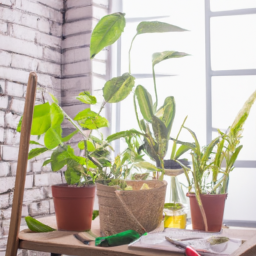
Winter Indoor Plant Care: Protecting Your Plants from Cold and Dry Conditions
During the winter season, it is crucial to provide proper care for your indoor plants as they are susceptible to cold and dry conditions. By following these steps, you can ensure that your plants thrive even in the harshest winter weather.
1. Adjusting Temperature and Humidity
First and foremost, it is important to maintain the right temperature and humidity levels for your indoor plants during winter. Most houseplants prefer temperatures between 60-75°F (15-24°C) during the day and slightly cooler temperatures at night. However, some plants, such as succulents, prefer cooler temperatures around 55-60°F (13-15°C) during the winter months.
To maintain the right humidity levels, you can use a humidifier or place a tray filled with water near your plants. This will help counteract the dry indoor air caused by heating systems. Additionally, misting your plants with water can also provide temporary relief from dry conditions.
It is important to monitor the temperature and humidity levels regularly to ensure your plants are comfortable and thriving throughout the winter season.
2. Adjusting Light and Watering
During winter, the days are shorter, and the intensity of sunlight is reduced. As a result, it is crucial to adjust the light exposure for your indoor plants. Place them near windows where they can receive maximum sunlight during the day. If your plants are not receiving enough natural light, you can supplement it with artificial grow lights.
Watering your plants correctly is also vital during winter. With reduced light and lower temperatures, plants require less water. Overwatering can lead to root rot and other fungal diseases. Before watering, always check the moisture level of the soil by inserting your finger about an inch deep. If it feels dry, it’s time to water. However, if it feels moist, it’s best to wait a few more days before watering again.
Remember, it’s always better to underwater than overwater your plants during winter.
3. Preventing Drafts and Cold Damage
Winter drafts can be harmful to your indoor plants, so it’s important to protect them from cold air. Avoid placing your plants near drafty windows, doors, or vents. Cold air can cause leaf damage and even kill your plants.
Consider using insulating materials, such as bubble wrap or plant covers, to shield your plants from cold drafts. These materials can help maintain a stable temperature around the plants and protect them from sudden temperature drops.
If you live in an area with extremely cold temperatures, you may want to move your plants away from windows altogether and place them in a warmer part of your home, such as a room with consistent temperatures.
By following these steps, you can ensure that your indoor plants stay healthy and vibrant during the winter season. Remember to monitor their condition regularly and make adjustments as needed. With proper care, your plants will thrive and bring joy to your indoor space all year round.
Summary Snapshot
Taking care of indoor plants can be a rewarding and fulfilling experience, but it’s important to remember that their needs can vary depending on the season. To ensure that your plants thrive all year round, it’s crucial to adjust your care routine accordingly. In the spring and summer months, when the days are longer and the temperatures are warmer, your plants will require more water and sunlight. Be sure to check the soil moisture regularly and water them when it feels dry to the touch. Additionally, consider moving your plants closer to windows or even outside for some fresh air and extra sunlight. Don’t forget to rotate them every few weeks to ensure even growth and prevent them from leaning towards the light source.
As we transition into fall and winter, the days become shorter and the temperatures drop. During this time, it’s essential to reduce watering frequency as the plants’ growth slows down. Overwatering can lead to root rot and other issues, so be cautious and only water when the top inch of soil feels dry. Since the amount of sunlight decreases, you may want to consider supplementing with artificial light or placing your plants near the brightest windows in your home. Remember to keep them away from drafty areas and avoid placing them near heaters or vents that can cause dryness. By adjusting your care routine according to the season, you can ensure that your indoor plants stay healthy and vibrant all year round.
Curious Minds Asked, We Responded. Frequently Asked Questions:
Q1: What are some general tips for caring for indoor plants throughout the year?
A1: To keep your indoor plants healthy all year round, there are a few general tips to keep in mind. Firstly, ensure that your plants are placed in the appropriate lighting conditions for their specific needs. Regularly dust the leaves to allow for proper light absorption. Secondly, water your plants according to their individual requirements, taking care not to overwater or underwater. Lastly, be mindful of the temperature and humidity levels in your home, as these can affect plant health.
Q2: How should I care for indoor plants during the spring season?
A2: During spring, it’s important to give your indoor plants a fresh start. Start by checking for any signs of pests or diseases, and treat them accordingly. As the days get longer and brighter, adjust the positioning of your plants to maximize their exposure to sunlight. Increase watering frequency as the weather warms up, but always allow the soil to dry out slightly between waterings. Consider repotting any plants that have outgrown their current pots.
Q3: What care should I provide for indoor plants during the summer season?
A3: Summer can be a challenging season for indoor plants due to increased heat and humidity. Keep your plants away from direct sunlight during the hottest parts of the day to prevent leaf burn. Increase watering frequency to accommodate for the higher evaporation rate, but avoid waterlogging the soil. Consider misting the leaves of tropical plants to provide extra humidity. If possible, provide good air circulation to prevent fungal growth.
Q4: How do I care for indoor plants during the fall season?
A4: As autumn arrives, it’s time to prepare your indoor plants for the upcoming winter. Start by reducing the frequency of watering as the days become shorter and cooler. This helps prevent root rot caused by soggy soil. Remove any dead or yellowing leaves to maintain plant health. Consider moving your plants away from drafty areas or windows to protect them from cold drafts. Monitor humidity levels, as indoor heating can dry out the air.
Q5: What care should I provide for indoor plants during the winter season?
A5: Winter can be a challenging time for indoor plants due to lower light levels and drier air. Place your plants near windows to maximize their exposure to natural light. Be cautious not to let them touch cold windows, as this can cause damage. Reduce watering frequency further, allowing the soil to dry out more between waterings. Consider using a humidifier or placing a tray of water near your plants to increase humidity levels.

James Wong is a renowned ethnobotanist, plant scientist, and local television presenter. With a passion for demystifying plant science, he is known for translating complex botanical concepts into practical advice for everyday plant enthusiasts. James’s expertise spans from traditional gardening to cutting-edge plant technologies, making his insights accessible and informative.

